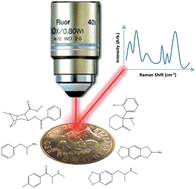Deposition of silver onto British 2p coins has been demonstrated as an efficient and cost effective approach to producing substrates capable of promoting surface enhanced Raman scattering (SERS). Silver application to the copper coins is undemanding taking just 20 s, and results in the formation of multiple hierarchial dendritic structures. To demonstrate that the silver deposition sites were capable of SERS the highly fluorescent Rhodamine 6G (R6G) probe was used. Analyses indicated that Raman enhancement only occurs at the silver deposition sites and not from the roughened copper surface. The robustness of the substrate in the identification and discrimination of illegal and legal drugs of abuse was then explored. Application of the drugs to the substrates was carried out using spotting and soaking methodologies. Whilst little or no SERS spectra of the drugs were generated upon spotting, soaking of the substrate in a methanolic solution of the drugs yielded a vast amount of spectral information. Excellent reproducibility of the SERS method and classification of three of the drugs, 4-methylmethcathinone (mephedrone), 5,6-methylenedioxy-2-aminoindane (MDAI) and 3,4-methylenedioxy-N-methylamphetamine (MDMA) were demonstrated using principal components analysis and partial least squares.

You have access to this article
 Please wait while we load your content...
Something went wrong. Try again?
Please wait while we load your content...
Something went wrong. Try again?


 Please wait while we load your content...
Please wait while we load your content...